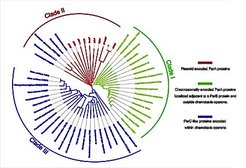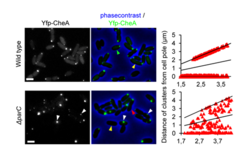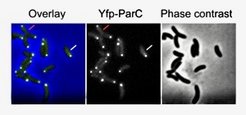Polar localization of chemotactic signaling arrays in Vibrio cholerae and Vibrio parahaemolyticus
Bacterial chemotaxis proteins are organized into ordered arrays. In peritrichous organisms, such as Escherichia coli, stochastic assembly processes are thought to account for the placement of chemotaxis arrays, which are nonuniformly distributed to cell poles and along the cell length. Using bioinformatics, we identified a new family of ParA-like ATPases (designated ParC) encoded within chemotaxis operons of many polar-flagellated g-proteobacteria (including both mono- and lophotricous bacteria).

ParC actively and in an ATP dependent manner promotes polar localization and inheritance of chemotaxis proteins. In the presence of ParC, chemotactic signaling arrays localize to the bacterial cell poles in a cell cycle dependent manner. In young cells signaling arrays localize solely to the old flagellated pole. Later in the cells cycle they are recruited to the new pole by ParC, hereby establishing a bipolar localization pattern, which ensures each daughter cell inherits a signaling array at its old pole upon cell division. In the absence of ParC, signaling arrays are no longer properly positioned at the cell poles and instead form randomly along the cell length.
Interestingly, we also discovered that ParC is localized at the flagellated old pole in newborn cells, and later as the cell matures it is recruited to the new pole - a localization similar to that of signaling arrays. However, ParC always was recruited to the new pole prior to the signaling arrays, which is consistent with ParC recruiting arrays at this site.

We showed that the cell cycle-dependent redistribution of ParC occurs by its release from the old pole and subsequent relocalization at the new pole, consistent with a diffusion-and-capture model for ParC dynamics. Chemotaxis proteins encoded in the same cluster as ParC have a similar uni- to bipolar transition; however, they reach the new pole after the arrival of ParC. Cells lacking ParC exhibit aberrantly localized signaling arrays, reduced chemotaxis, and altered motility.

Recently we identified a previously uncharacterized protein, ParP, that interacts with ParC. ParP is integral to chemotactic signaling array localization in Vibrio cholerae and Vibrio parahaemolyticus. ParC's principal contribution to chemotaxis appears to be via positioning of ParP. Once recruited to the pole by ParC, ParP sequesters arrays at this site by capturing and preventing the dissociation of chemotactic signaling protein. Notably, ParP also stabilizes chemotactic protein complexes in the absence of ParC, indicating that some of its activity is independent of this interaction partner. ParP interacts with CheA via CheA's localization and inheritance domain (LID), a region found only in polarly flagellated organisms that encode ParP, ParC, and CheA. Thus, a tripartite (ParC-ParP-CheA) interaction network enables the polar localization and sequestration of chemotaxis arrays in polarly flagellated organisms. Localization and sequestration of chemotactic arrays adjacent to the flagella - to which the chemo- tactic signal is transmitted - facilitates proper chemotaxis as well as accurate inheritance of these macromolecular machines. Collectively, our findings indicate that ParC-ParP promotes the efficiency of chemotactic signaling processes and in particular show that ParC/ParP-facilitated development of a functional chemotaxis apparatus at the new pole readies this site for its development into a functional old pole after cell division and ensures the inheritance of this macromolecular structure to daughter cells - enabling them to respond immediately after division to changes in their environments. However, the exact mechanisms behind ParC-ParP mediated localization remains to be elucidated. Furthermore, it is not know how ParC itself is recruited to the pole. We are continuing to address these questions in order to completely understand how polarity is established in Vibrios.
Ringgaard, S., Zepeda-Rivera, M., Xiaoji, W., Schirner, K., Davis, B.M., Waldor, M.K. (2014) ParP prevents dissociation of CheA from chemotactic signaling arrays and tethers them to a polar anchor. Proc Natl Acad Sci U S A. Jan 14;111(2):E255-64
Yamaichi, Y., Bruckner, R., Ringgaard, S., Möll, A., Cameron, D.E., Briegel, A., Jensen, G.J., Davis, B.M., Waldor, M.K. (2012) A multidomain hub anchors the chromosome segregation and chemotactic machinery to the bacterial pole. Genes Dev. Oct 15;26(20):2348-60
Ringgaard, S., Schirner, K., Davis, B.M., Waldor, M.K. (2011) A family of ParA-like ATPases promotes cell pole maturation by facilitating polar localization of chemotaxis proteins. Genes Dev. Jul 15;25(14):1544-55


